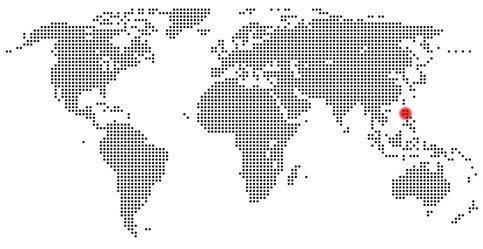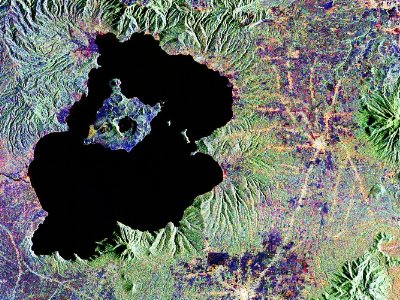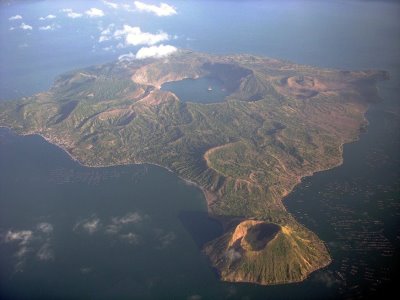
 The Taal Volcano is located on the main Philippine island of Luzon, only 50 kilometers from Manila. More than 21 million people live in the metropolitan area of the Philippine capita. For them the highly explosive subduction zone volcano is a potential threat.
The Taal Volcano is located on the main Philippine island of Luzon, only 50 kilometers from Manila. More than 21 million people live in the metropolitan area of the Philippine capita. For them the highly explosive subduction zone volcano is a potential threat.
The 400 meter high Taal volcano is located in a caldera with a diameter of 25 x 30 km. It was formed in a highly explosive phase of the volcano which occurred between 140,000 and 7,380 years before today. In the literature there are different statements about the period of the caldera genesis. Some sources report that the caldera formation took place in a period between 1.000.000 and 500.000 years before today.
Mighty layers of ignimbrite indicate that pyroclastic flows flowed far beyond the present urban area of Manila. In this respect, the caldera shows similarities to the Yellowstone volcano. It is not clear whether a so-called super volcano eruption occurred at that time, but the size of the caldera at least suggests that the eruption had at least a VEI 7.
The new volcanic island
In the caldera formed a lake and in a later stage a new volcanic island, today's Taal volcano, was created in this lake. The new volcanic island is 23 square kilometers in size and eruptions produced 47 craters and smaller cones, including several maars. In the main crater of the Taal volcano a crater lake with a diameter of 2 km was formed, in which a small cinder cone was formed. This cinder cone is called "Vulcan Point". Thus the Taal caldera offers a nested island-lake-island-lake-island system.
The new volcanic island is 23 square kilometers in size and eruptions produced 47 craters and smaller cones, including several maars. In the main crater of the Taal volcano a crater lake with a diameter of 2 km was formed, in which a small cinder cone was formed. This cinder cone is called "Vulcan Point". Thus the Taal caldera offers a nested island-lake-island-lake-island system.Since 1572, 33 eruptions have become known. The strongest eruptions occurred in 1754 and 1911, the 1754 eruption occurred between May and December. During this time there were several paroxysmal eruptions which produced a lot of tephra and buried some fishing villages at the lake under ashes.
During the 1911 eruption more than 1300 people lost their lives. Volcanic ash rained down on Manila.
Since the 1990s, there have been frequent periods of increased quake activity and higher water temperatures, indicating the intrusion of magma underground.
The most recent eruptive phase lasted from 1965 to 1977, with most of the eruptions being phreatomagmatic in nature and originating from Mount Tabaro. One of the strongest eruptions of this period was the initial eruption of 1965, which generated pyroclastic base surges. This phenomenon is similar to pyroclastic flows, but base surges are usually colder and contain more fine material. They destroyed several villages and killed over 100 people.
In 1968 and 1969 there were two phases of strombolian eruptions.
Activity of the new Millenium
In the recent past 2 of these phases have been observed. The first began on 26 April 2010 with the increase in seismic activity. By 24 May, the water temperature of the lake had risen by 3 degrees and the gas emission of the fumaroles increased, as did the basal deformation. Here the volcano expanded by 3 mm.The Philippine Institute of Vocanology and Seimsmology increased the warning level to Level 2 and the island volcano was forbidden to enter.
Phase 2 started on 08.04.2011. The seismic activity under the volcano increased. Within 24 hours 21 earthquakes occurred. Some of them just below the "volcano point". Some quakes were at depths between 1-4 km. In addition, carbon dioxide emissions increased 4-fold to over 4600 tons per day. Again, access to the volcano was closed.
On April 8, 2017, a series of medium strong earthquakes occurred at a distance of only 15 km from the volcano. The strongest one occurred on M 5.7 at a depth of 10 km.
Due to the high risk potential caused by the volcano's close proximity to the capital, the Taal is one of the best observed volcanoes in the world.